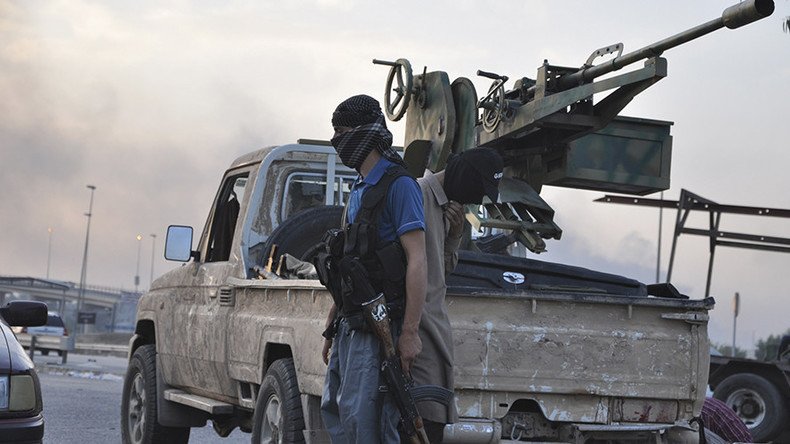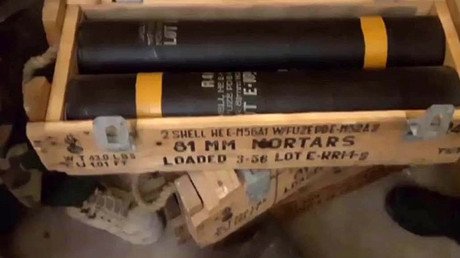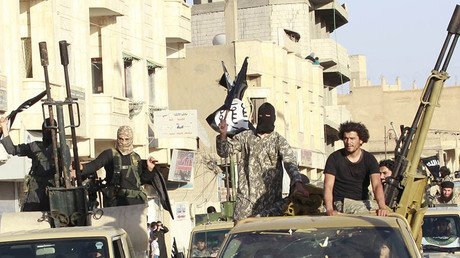Putin: One day weapons go to ‘moderate opposition,’ the next they are with terrorists

Russian President Vladimir Putin has said certain clandestine supplies of arms to conflict zones are apparently primarily motivated by profit rather than geopolitical considerations. He called this “irresponsible” and unbefitting of any state.
Speaking at an arms export commission in Moscow, Putin stressed that while selling weapons is a multibillion-dollar business for Russia, it ensures that the bottom line never undermines the stability of the regions to which the weapons are delivered. He said this approach contrasted with that of “some actors in the arms market,” refraining from naming the culprits, but apparently referring to the US and several of its allies.
“Instead of a genuine fight against terrorist groups we see a simulation of this fight while uncontrolled arms deliveries grow. One day the weapons go to so-called ‘moderate opposition’ in this or that place, and the next day they are in the hands of radicals and terrorists,” Putin said. “It appears that the conflict zones have become for some just a lucrative business, a link in the chain of ‘gray’ schemes of supply of arms to nations and regions suffering from military and political instability.”
The US and its allies such as Qatar and Saudi Arabia have supported armed groups opposing the government of Syrian President Bashar Assad over the past six years, including through clandestine supplies of weapons and military hardware.
On too many occasions these weapons ended up in the hands of radical Islamist groups, including Islamic State (IS, formerly ISIS/ISIL) and Al-Nusra Front, both designated as terrorists by the US. The problem was acknowledged in Washington, but it didn’t stop the deliveries.
“There is no way” the US can control all its weapon supplies delivered to various armed factions in crisis areas around the world, Michael Maloof, a former Pentagon official told RT. He particularly emphasized the example of Syria, where arms airdropped by the US to armed opposition groups eventually lands in the hands of Islamic State (IS, formerly ISIS/ISIL).
“We experienced total chaos in many ways in various regions of Syria,” Maloof said. He added that the US could not effectively control the flows of weapons in the war-torn country because all the armed groups operating there, including the extremist and terrorist formations, are working with each other. Maloof went on to say that in some cases, enabling Islamic State to get hold of US weapons was “a calculated thing,” because Washington's primary goal in Syria is to topple Assad.
Maloof also said it is “absolutely essential” for the defense industry to conduct such arms sales, and for there to be “chaos in different parts of the world.”
“If peace were to break out all over, of course there wouldn't be a need for these elaborate and very expensive arms, but that's not the case,” he said.
US arms supplied to state buyers rather than militant groups are also not always safe. IS infamously captured a large arsenal of American military vehicles and heavy weapons when it seized the Iraqi city of Mosul in 2014. The majority of weapons seized from IS by the advancing Syrian Arab Army, which were demonstrated by Damascus, were American-made, military journalist Viktor Litovkin told RT.
“Just a week ago the Syrian government army showed the stockpiles of weapons it took from IS. There were assault rifles, machine guns, other small arms, anti-tank missiles, mortars and whatever. It took almost an entire stadium to hold. There were even drones. And they were made in America,” he said.
A lack of accountability for US-provided weapons is also endemic in Afghanistan. Hundreds of millions of dollars’ worth of lethal hardware disappeared without a trace in the county since the US-led invasion in 2001.
US claims that it has safeguards to prevent such incidents are empty talk not founded in reality, military analyst Konstantin Sivkov told RT. “They don’t control even the people they train. A couple of years ago CIA sources admitted that an absolute majority of the ‘moderate opposition’ fighters they had trained ended up in the ranks of IS. Only a handful remained moderate. And they took their US-provided arms to Islamic State too.”
“Armed irregular forces have an inclination to morph, that’s part of their nature. So there is absolutely no way to control their arms,” he added. Sivkov agreed with Putin that ‘gray’ arms deliveries could be profitable to those involved, including manufacturers, senior officials making decisions on the supply chain and intermediaries on the ground.













